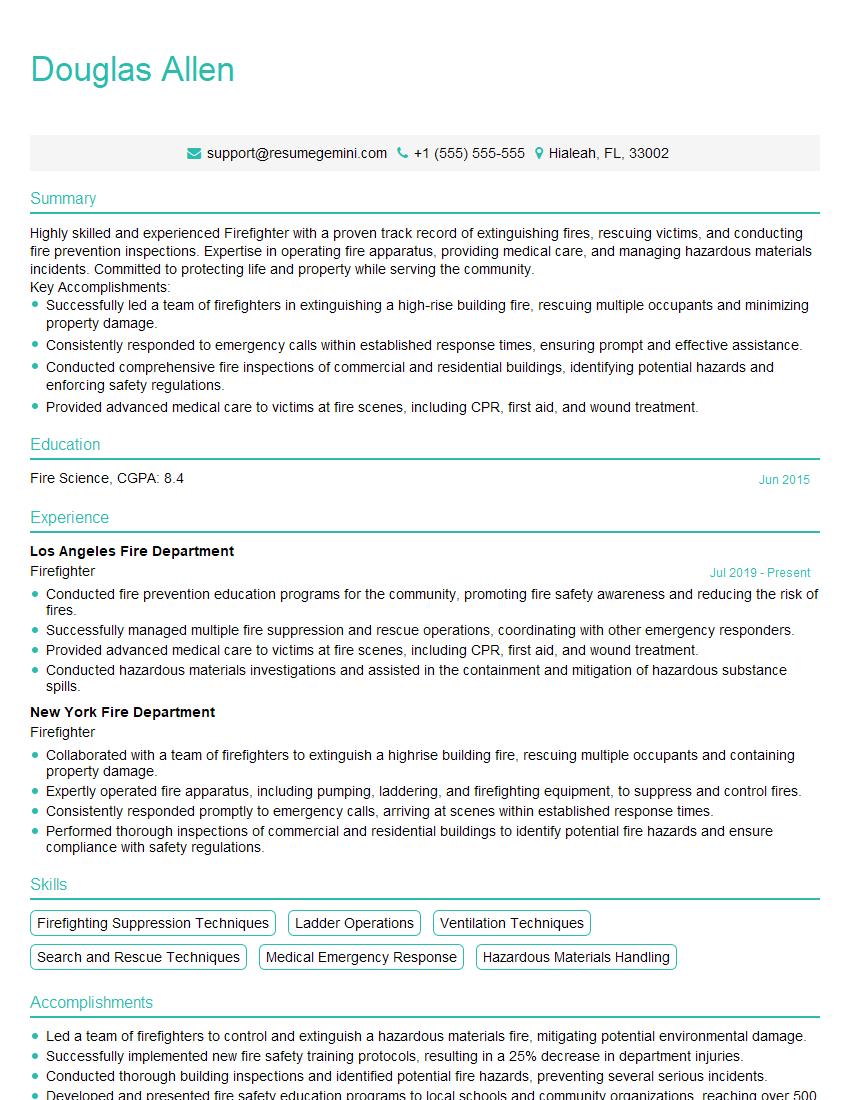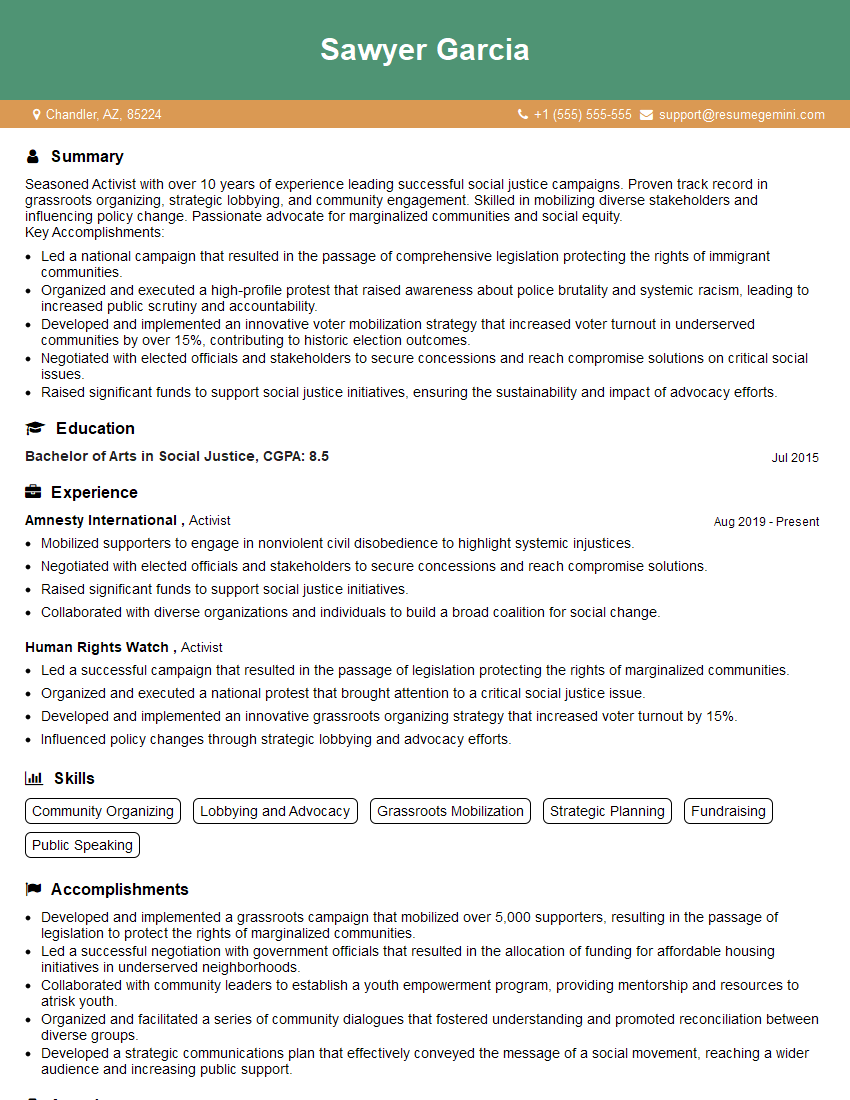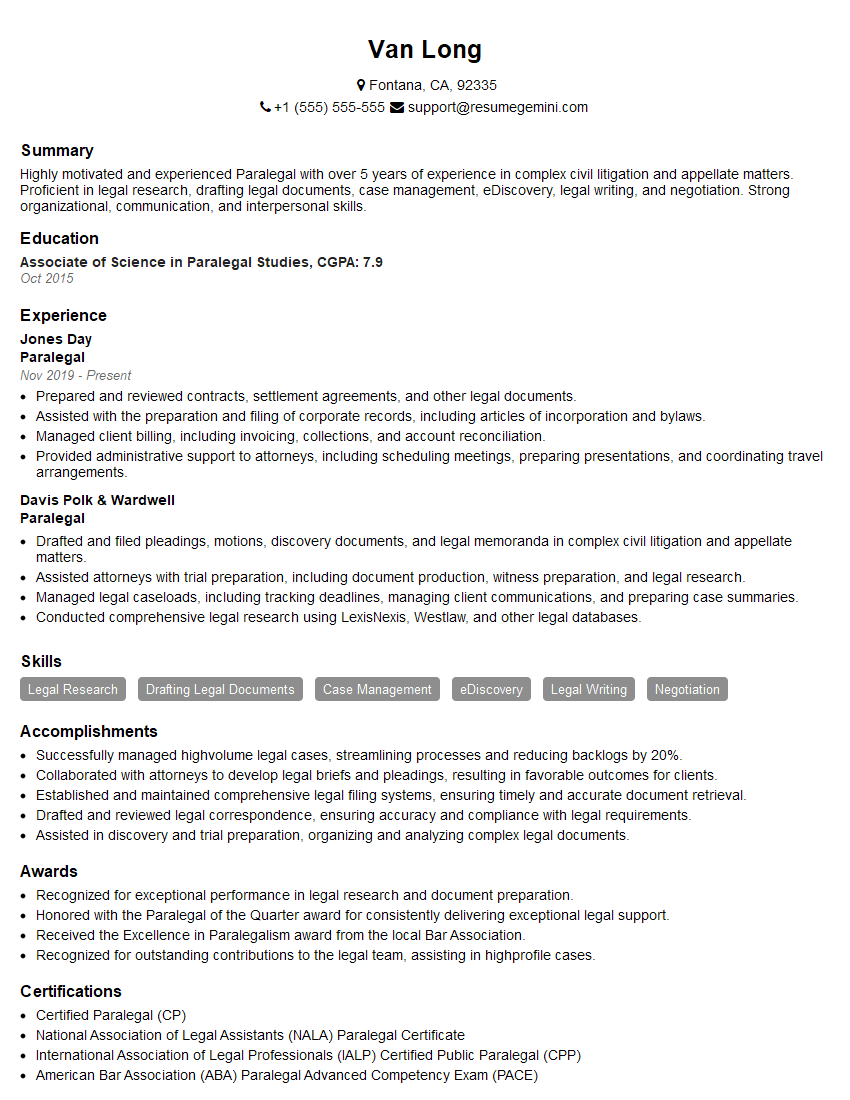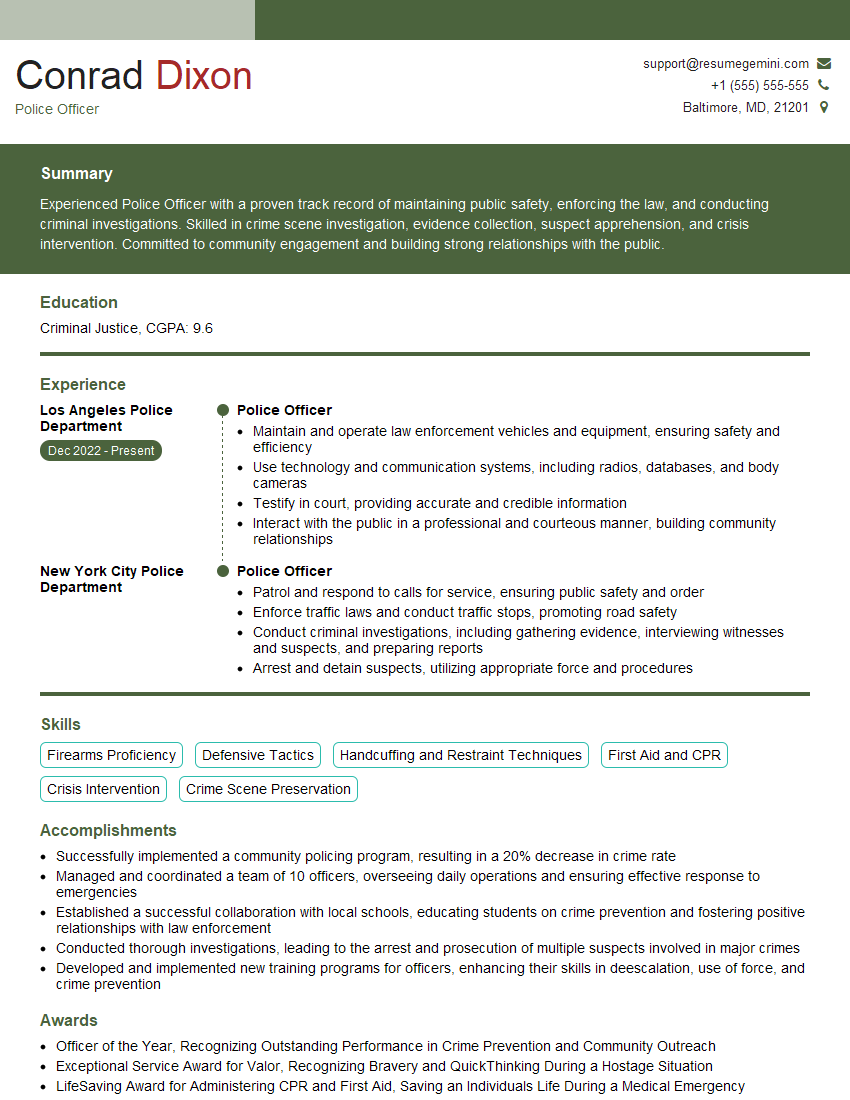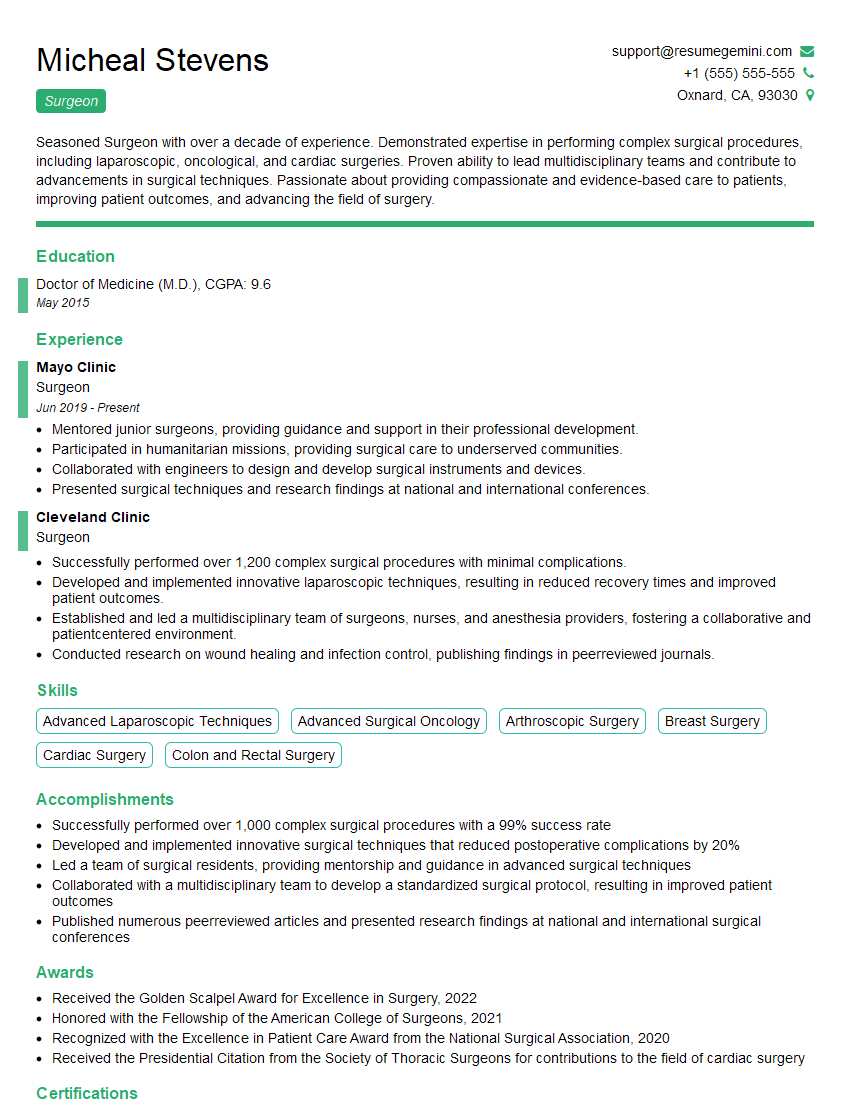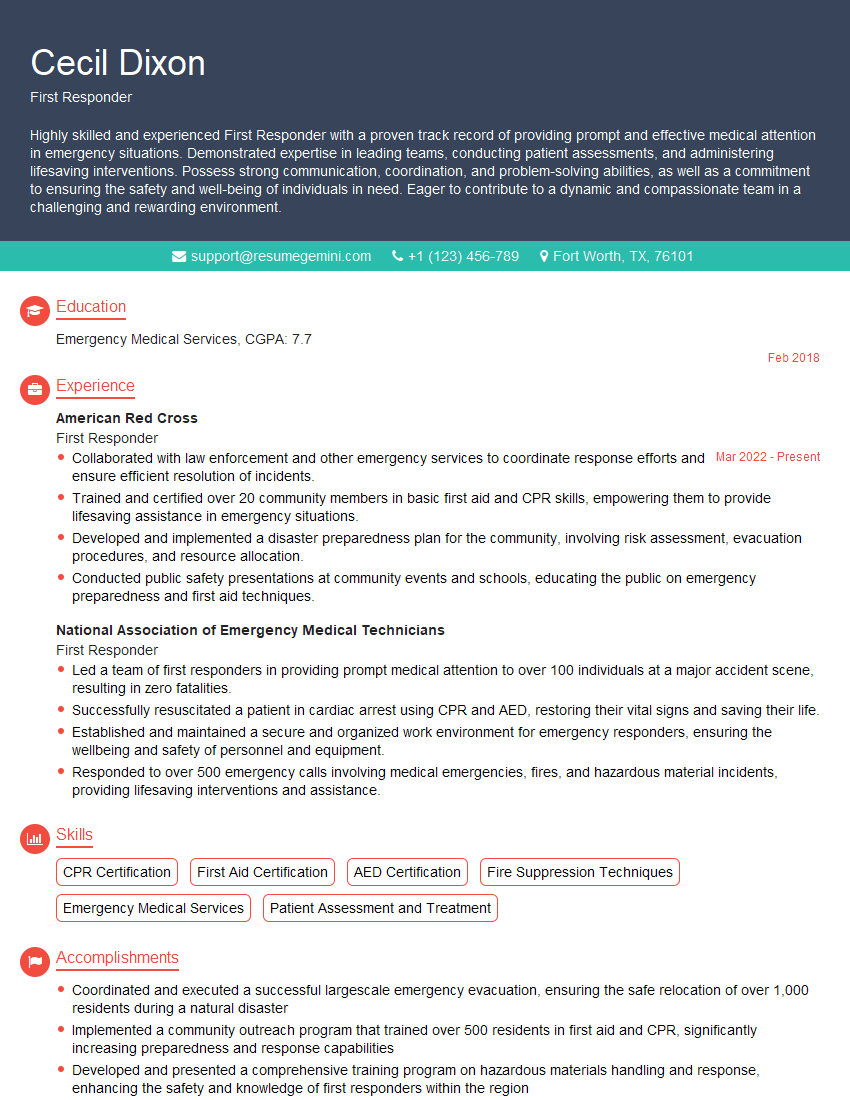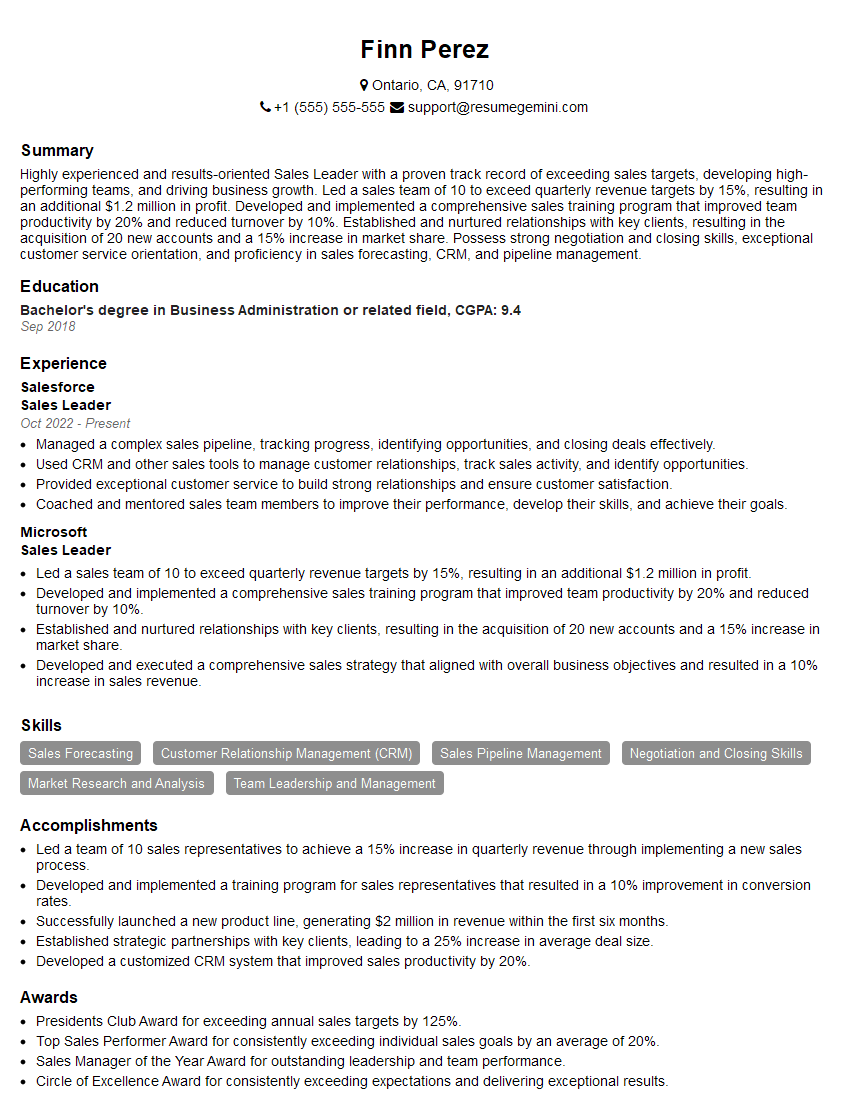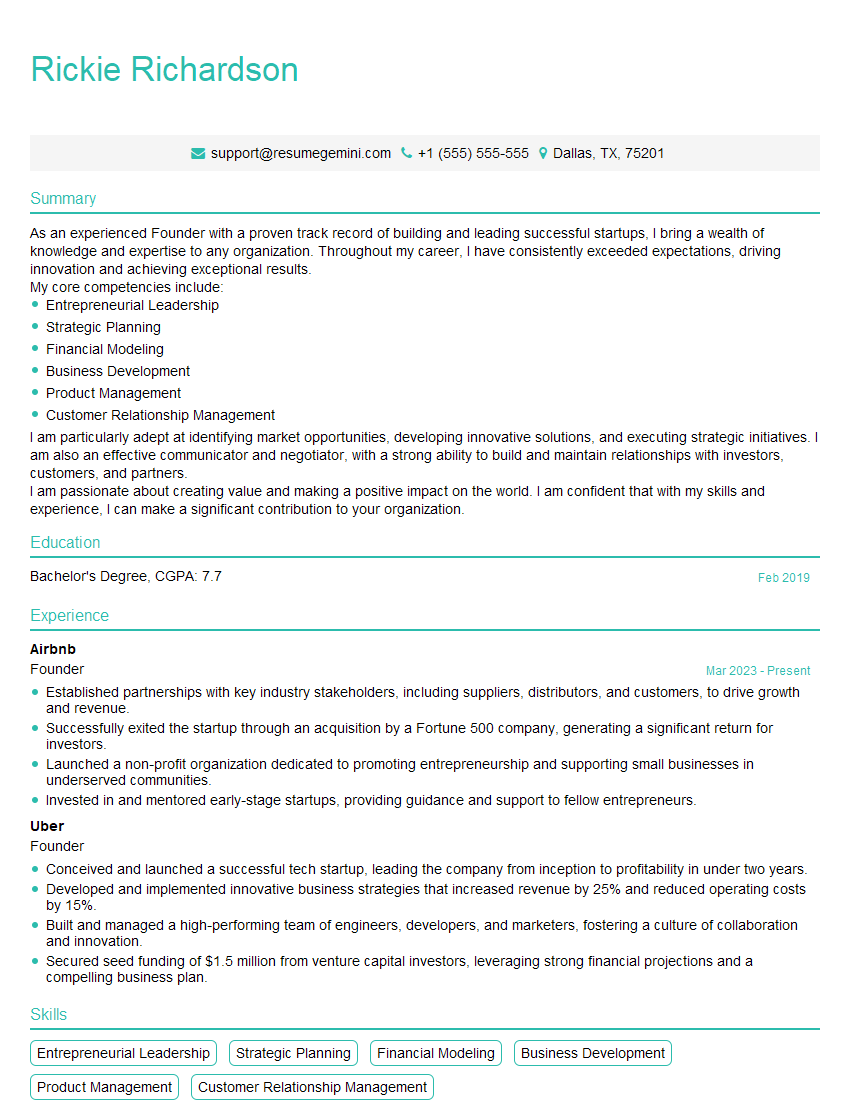Are you ready to stand out in your next interview? Understanding and preparing for Courage interview questions is a game-changer. In this blog, we’ve compiled key questions and expert advice to help you showcase your skills with confidence and precision. Let’s get started on your journey to acing the interview.
Questions Asked in Courage Interview
Q 1. Describe a time you had to make a difficult decision despite potential negative consequences.
Courage often involves navigating difficult decisions with potential downsides. It’s not about recklessness, but about carefully weighing risks and benefits, acknowledging the fear, and proceeding with conviction based on your values and assessment.
In my previous role, our team faced a critical project deadline. We were severely behind schedule, and the initial plan, while safe, risked missing the deadline entirely. The alternative was a high-risk, high-reward approach involving a significant technological leap. This meant a potential for complete failure, jeopardizing our project and potentially our reputations. After careful analysis involving the team, we chose the risky route, understanding the potential negative repercussions. We communicated the risks transparently, mitigated them where possible with a robust contingency plan, and ultimately succeeded, exceeding expectations. This decision exemplified calculated courage, prioritizing the long-term benefits despite significant short-term uncertainties.
Q 2. How have you demonstrated courage in the face of adversity?
Adversity tests the mettle of courage. It’s about resilience, perseverance, and maintaining integrity under pressure. It’s not the absence of fear, but the ability to act despite it.
During a major organizational restructuring, I was faced with the prospect of redundancy. Instead of succumbing to despair, I used this as an opportunity to showcase my skills and adaptability. I proactively sought out new opportunities within the company, highlighting my contributions and aligning my skills with emerging needs. I networked extensively, maintained a positive attitude, and ultimately secured a new position that better suited my long-term career goals. This demonstrated not only professional resilience but also a courageous response to a challenging situation.
Q 3. Describe a situation where you had to speak truth to power.
Speaking truth to power requires courage. It involves expressing dissenting opinions or highlighting ethical concerns to those in authority, even when it might be risky or unpopular. It’s about honesty, integrity, and a commitment to doing what is right, regardless of the potential consequences.
In a past project, I identified a significant flaw in a proposed strategy that had been championed by senior management. While initially hesitant, I meticulously documented my concerns, backed by data and analysis. I then presented my findings to the team, clearly explaining the potential risks and suggesting alternative solutions. Although my suggestions initially faced resistance, the evidence was compelling enough to initiate a review and ultimately lead to a revised, safer strategy. This experience reinforced the importance of voicing concerns, even when challenging authority figures.
Q 4. Have you ever had to challenge a decision you believed was unethical or unsafe? How did you handle it?
Challenging unethical or unsafe practices requires significant courage. It demands a strong moral compass, the ability to assess risk effectively, and a willingness to potentially face repercussions. The approach should be thoughtful and strategic, focusing on presenting facts and solutions rather than confrontational tactics.
Once, I witnessed a colleague engaging in data manipulation to inflate project performance metrics. Instead of ignoring it, I first privately addressed my concerns with the colleague, emphasizing the ethical and professional implications. When this didn’t resolve the issue, I documented the incidents and escalated the matter to the appropriate management channels, ensuring my concerns were presented with supporting evidence and a focus on solutions to prevent further occurrences. While it was uncomfortable, prioritizing ethical conduct was paramount.
Q 5. How do you handle criticism or setbacks that may threaten your self-confidence?
Resilience is crucial in the face of criticism or setbacks. It’s not about ignoring criticism, but about processing it constructively and using it as a learning opportunity. Maintaining self-confidence requires self-awareness, self-compassion, and a strong understanding of your strengths and areas for growth.
I’ve learned to approach criticism as feedback, analyzing it objectively to determine whether it’s valid and actionable. I focus on separating the message from the messenger, focusing on the information provided rather than the emotional tone. I use constructive criticism to refine my skills and improve my performance. Setbacks are viewed as opportunities to learn and adapt, reinforcing my determination to achieve my goals.
Q 6. Describe a situation where you had to take a calculated risk.
A calculated risk involves a conscious decision to pursue a potentially high-reward outcome, despite knowing there’s a chance of significant loss. It’s about careful planning, assessing probabilities, and having a contingency plan in place. It’s not about gambling, but about strategic decision-making under uncertainty.
In my career, I once opted to lead a new initiative with limited resources and an unclear market demand. This involved a significant risk, as failure could have impacted my career trajectory. However, I developed a detailed business plan, mitigating risks through phased implementation and robust data analysis at each stage. This allowed us to adapt and pivot as needed, eventually transforming the initiative into a successful project that exceeded expectations. This experience taught me the importance of meticulous planning and strategic risk-taking.
Q 7. What steps do you take to manage fear and anxiety in high-pressure situations?
Managing fear and anxiety in high-pressure situations requires proactive strategies. It’s about understanding your triggers and developing coping mechanisms. Techniques such as deep breathing, mindfulness, and visualization can be extremely effective.
Personally, I utilize a combination of techniques. Before high-pressure situations, I practice deep breathing exercises to calm my nerves. During the event, I focus on breaking down the task into smaller, manageable steps. I also utilize visualization to mentally rehearse success scenarios, building confidence. Furthermore, adequate preparation and planning significantly reduce anxiety by boosting self-efficacy. A well-defined plan minimizes uncertainties and helps manage fear by fostering a sense of control.
Q 8. How do you balance courage with caution?
Balancing courage and caution is about finding the sweet spot between reckless bravery and paralyzing fear. It’s not about eliminating caution, but rather about integrating it into your decision-making process. Think of it like navigating a tightrope – courage provides the forward momentum, while caution acts as your balance and awareness of potential pitfalls.
A useful framework is to consider the potential risks and rewards of any action. Ask yourself: What is the potential upside? What is the potential downside? Is the potential reward worth the risk? This risk assessment, informed by careful consideration of potential consequences, helps you act courageously, but not foolishly. For instance, starting a new business requires courage to take the leap, but thorough market research and a solid business plan exemplify caution.
- Assess Risks: Conduct thorough research and analysis to understand potential dangers.
- Weigh Rewards: Evaluate the potential benefits and outcomes.
- Develop a Plan B: Always have a contingency plan in case things don’t go as expected.
Q 9. Give an example of a time you stood up for your beliefs even when it was unpopular.
During a project review, my team and I discovered a significant flaw in our methodology that could lead to inaccurate results. Although presenting this information meant potentially delaying the project and facing criticism, I believed in the importance of accuracy and data integrity. I presented the findings, detailing the potential consequences and proposing alternative solutions. While it wasn’t the easiest conversation, the team appreciated the transparency and the improved methodology ultimately yielded better, more reliable results. It was unpopular in the short term because it delayed a deadline, but it proved to be the more courageous and ultimately better decision in the long run.
Q 10. How do you maintain your courage in the face of uncertainty?
Maintaining courage in uncertainty requires focusing on what you *can* control, rather than dwelling on the unknowns. This involves proactive planning, building resilience, and fostering a belief in your abilities. It’s about having faith in your preparation and trusting your instincts.
- Focus on Controllables: Identify aspects you can influence (effort, preparation, attitude) and concentrate your energy there.
- Embrace Preparation: Thorough preparation reduces anxiety and builds confidence in your ability to handle unexpected challenges.
- Develop Resilience: Cultivate the ability to bounce back from setbacks and view challenges as opportunities for growth. This involves learning from mistakes and focusing on progress, not perfection.
Think of it as preparing for a marathon. You can’t control the weather, but you *can* control your training and mental preparation. That control builds confidence and courage to face the unknown race day.
Q 11. Describe a time you had to make a decision with incomplete information.
I once had to decide whether to launch a new marketing campaign with only partial data on market trends. While the full market research wasn’t complete, the available data suggested a significant opportunity. I weighed the potential benefits against the risks of incomplete information. My strategy involved a phased rollout of the campaign, allowing for adjustments based on real-time performance data. This allowed us to mitigate the risks associated with incomplete information while seizing the opportunity presented by the partial data.
The key was a structured decision-making process that included:
- Data Analysis: Thoroughly analyzing available data to identify trends and potential risks.
- Risk Assessment: Weighing the potential negative consequences of a decision against potential benefits.
- Adaptive Strategy: Designing a flexible plan that could be adapted based on new information and performance data.
Q 12. How have you learned from past failures and used those experiences to build courage?
Past failures, rather than being sources of shame, have become invaluable lessons in building resilience and courage. Each setback has provided crucial insight into my strengths and weaknesses, enabling me to refine my approach. For example, a failed project taught me the critical importance of effective team communication and proactive risk management. Instead of dwelling on the failure, I focused on learning from it, which empowered me to approach future challenges with greater confidence and a more robust strategy.
Q 13. What are your strategies for overcoming fear of failure?
Overcoming the fear of failure involves reframing the narrative around failure itself. Instead of viewing failure as an indicator of personal inadequacy, it’s crucial to view it as a necessary step in learning and growth. This perspective shift requires a combination of self-compassion, focusing on learning, and building confidence through small wins.
- Reframe Failure: See failure as valuable feedback, not a judgment on your worth.
- Celebrate Small Wins: Acknowledge and appreciate your successes, no matter how small. This helps build momentum and confidence.
- Focus on Learning: After a setback, focus on extracting lessons learned and applying that knowledge to future endeavors.
- Develop a Growth Mindset: Embrace challenges as opportunities to learn and grow.
Q 14. Describe a time you had to confront a difficult person or situation.
I once had to confront a senior colleague whose behavior was undermining team morale and project success. I approached the situation strategically, documenting specific instances of the problematic behavior and preparing a plan for a constructive conversation. During the discussion, I focused on the impact of their actions on the team and the project, rather than on attacking their personality. My goal wasn’t confrontation for its own sake, but to address the issues in a professional and collaborative manner. The conversation was difficult, but it resulted in positive changes in their behavior and improved team dynamics.
The key was to:
- Prepare Thoroughly: Document specific instances and develop a clear plan for the conversation.
- Focus on Impact: Explain the consequences of the behavior rather than attacking the person.
- Seek Collaboration: Aim for a solution that benefits everyone involved.
- Maintain Professionalism: Keep the discussion focused and respectful.
Q 15. How do you build courage in yourself and others?
Building courage, both in oneself and others, is a process of fostering self-belief and resilience. It’s not about recklessness, but about acting despite fear. For oneself, this involves identifying fears, understanding their roots, and gradually exposing oneself to them in a controlled manner. This could involve setting small, achievable goals that push one’s comfort zone. For example, if public speaking terrifies you, start with speaking to a small, trusted group before larger audiences. For others, it’s about creating a safe and supportive environment where vulnerability is accepted and risk-taking is encouraged. This means actively listening to concerns, offering constructive feedback, and celebrating successes, big or small. Providing opportunities for growth and recognizing bravery in action are also crucial. Think of it like building muscle: consistent effort strengthens both individual and collective courage.
- Self-Compassion: Acknowledge that fear is natural. Treat yourself kindly during setbacks.
- Gradual Exposure: Start with small challenges to build confidence.
- Positive Self-Talk: Replace negative thoughts with empowering affirmations.
- Supportive Environment: Create a space where vulnerability and risk-taking are valued.
- Role Modeling: Demonstrate courage in your own actions.
Career Expert Tips:
- Ace those interviews! Prepare effectively by reviewing the Top 50 Most Common Interview Questions on ResumeGemini.
- Navigate your job search with confidence! Explore a wide range of Career Tips on ResumeGemini. Learn about common challenges and recommendations to overcome them.
- Craft the perfect resume! Master the Art of Resume Writing with ResumeGemini’s guide. Showcase your unique qualifications and achievements effectively.
- Don’t miss out on holiday savings! Build your dream resume with ResumeGemini’s ATS optimized templates.
Q 16. Describe a situation where you had to defend someone else’s rights or ideas.
In a previous team project, a colleague presented a novel approach that was initially met with resistance from senior management due to its unconventional nature. While others remained silent, I felt it was crucial to defend its merit. I prepared a detailed presentation, highlighting the potential benefits and addressing the concerns raised by management. I used data to support our colleague’s claims and emphasized the innovative potential of the approach. My argument wasn’t solely focused on defending my colleague; it was about advocating for a better solution, even if it meant challenging established norms. The result was a reevaluation of the project, and the team’s proposal, after some refinements, was ultimately approved.
Q 17. How do you handle conflict that requires courage to address?
Handling conflict courageously involves a structured approach. First, it’s crucial to ensure a safe space for open communication. Active listening is paramount: understanding the other person’s perspective is key before attempting to resolve the issue. Then, I clearly and respectfully state my concerns, focusing on the issue at hand rather than resorting to personal attacks. If emotions are running high, taking a brief pause to regain composure can be helpful. I then work collaboratively to find a mutually acceptable solution, focusing on compromise and finding common ground. Sometimes, despite best efforts, resolution is impossible. In such cases, I document the conflict and actions taken, ensuring transparency and accountability.
- Active Listening: Understand all perspectives.
- Clear Communication: State your concerns respectfully.
- Collaboration: Work towards a mutually acceptable solution.
- Documentation: Record the conflict and resolution attempts.
Q 18. Give an example of a time you took initiative despite potential obstacles.
During a period of significant budget cuts, our team faced the challenge of maintaining morale and productivity. Recognizing the potential for negative consequences, I took the initiative to propose a new team-building program focused on creative problem-solving and collaboration. Despite limited resources and initial skepticism from management, I secured funding for the program by demonstrating its potential for improving team cohesion and boosting overall performance. This initiative not only lifted team morale but also resulted in increased efficiency and innovation, ultimately proving the value of my proactive approach. The obstacles were navigating budgetary constraints and gaining management buy-in but focusing on the positive outcomes and presenting a clear plan helped me overcome this challenge.
Q 19. Describe a time you had to persevere despite facing significant challenges.
I once led a project that faced multiple setbacks, including unexpected technical difficulties, shifting deadlines, and team member attrition. Despite these challenges, I remained committed to the project’s success. I implemented a revised project plan, delegated tasks effectively, and provided consistent support to my team. Open communication and transparent updates were crucial in maintaining morale. Through consistent effort and problem-solving, we ultimately delivered the project successfully, albeit behind schedule. This experience reinforced my belief in the power of perseverance and the importance of adaptive leadership in overcoming adversity.
Q 20. How do you foster a culture of courage within a team?
Fostering a culture of courage involves creating an environment where individuals feel safe to take risks, voice dissent, and learn from mistakes. This includes:
- Open Communication: Establish channels for open dialogue and feedback.
- Psychological Safety: Ensure team members feel comfortable expressing themselves without fear of retribution.
- Celebrating Failure: Frame failures as learning opportunities, encouraging experimentation.
- Recognition & Reward: Acknowledge and reward courageous behavior.
- Lead by Example: Demonstrate courage in your own actions and decisions.
By consistently demonstrating these principles, leaders can cultivate a team that embraces challenges, promotes innovation, and drives positive change.
Q 21. How do you prioritize courage when faced with competing priorities?
Prioritizing courage when faced with competing priorities requires careful consideration of long-term consequences and values. While immediate priorities might seem pressing, neglecting courageous action can have far-reaching negative impacts. I use a framework that considers:
- Ethical Implications: Does this action align with my values and ethical responsibilities?
- Long-Term Impact: What are the potential consequences of both acting courageously and avoiding it?
- Risk Assessment: What are the potential risks and rewards of each course of action?
- Alignment with Goals: Does this action support the overall strategic goals?
By considering these factors, I can make informed decisions that align courage with strategic priorities, even when faced with conflicting demands.
Q 22. How do you identify and mitigate risks that may require courageous action?
Identifying and mitigating risks requiring courageous action involves a structured approach. First, we must accurately assess the potential threats. This requires careful analysis, considering the probability and impact of each risk. For example, launching a new product might risk financial losses if it fails to gain market traction. Next, we develop mitigation strategies. These could involve thorough market research, pilot programs, or contingency plans. The key is to proactively address potential problems, minimizing their impact should they occur. Finally, we must weigh the risks against the potential rewards. Sometimes, calculated risks are necessary for significant advancement. Courage isn’t about recklessness; it’s about making informed decisions despite uncertainty.
- Risk Identification: SWOT analysis, stakeholder interviews, scenario planning.
- Mitigation Strategies: Diversification, insurance, phased rollouts, robust testing.
- Risk-Reward Assessment: Quantify potential gains and losses, use decision-making frameworks like a decision matrix.
Q 23. Describe a time you had to overcome a personal limitation to achieve a goal.
My biggest personal limitation has always been public speaking. For years, I avoided presentations, fearing judgment and failure. However, for a critical project, I needed to deliver a presentation to senior executives. To overcome this, I developed a structured approach. I started with small presentations to colleagues, seeking feedback and building confidence. I practiced diligently, rehearsing my presentation multiple times until I felt comfortable. I also focused on preparing compelling content, making sure I understood the material thoroughly. Finally, I visualized success, imagining myself delivering a confident and impactful presentation. The result? Not only did I deliver a successful presentation, but I discovered a newfound confidence that extended to other areas of my life. This experience taught me that overcoming limitations requires intentional effort, preparation, and a belief in your ability to succeed.
Q 24. How do you adapt your approach to courage based on the context and situation?
Courage isn’t a one-size-fits-all approach. The context and situation significantly influence how I adapt my strategy. In a crisis situation requiring immediate action, decisive and swift courage is essential. For example, during a sudden power outage, quickly assessing the situation and directing the team’s response is crucial. In contrast, navigating complex ethical dilemmas requires a more thoughtful, deliberative type of courage. This involves careful consideration of all stakeholders and potential consequences before taking action. The key is to be self-aware, understand the nuances of the situation, and choose the most effective approach to address the challenge at hand.
Q 25. How do you use courage to drive innovation and positive change?
Courage is a fundamental driver of innovation and positive change. It takes courage to challenge the status quo, to propose unconventional ideas, and to persevere through setbacks. For example, introducing a new technology or process often requires overcoming resistance to change, skepticism from colleagues, and potential failures along the way. Courage allows us to persist despite these obstacles, pushing boundaries to create something new and better. Furthermore, speaking up against unethical practices or advocating for underrepresented groups requires significant courage. This kind of courageous action fosters a more equitable and just environment. By embracing courageous leadership, we can create organizations and communities that are more innovative, resilient, and ethically sound.
Q 26. Describe a time you took a stand on an issue that was important to you.
I once witnessed a colleague being unfairly treated due to a prejudiced misconception. While I initially hesitated, fearing potential repercussions, I ultimately decided to speak up. I approached my manager privately, presenting the facts and calmly explaining how the situation violated our company’s values of fairness and equality. My courage was rewarded, as the manager took immediate action, addressing the situation fairly and promoting a more inclusive workplace. This experience reinforced the importance of speaking up against injustice, even when it feels uncomfortable or risky. While the consequences were unknown at the time, the positive impact on both my colleague and the workplace justified the risk.
Q 27. How do you define courage, and how does your definition influence your actions?
I define courage as the willingness to act despite fear, uncertainty, and potential negative consequences. It’s not the absence of fear, but the conscious decision to act despite it. My definition influences my actions by encouraging me to take calculated risks and advocate for what is right, even when it’s difficult. It helps me to prioritize integrity and values over self-preservation, leading to more meaningful and impactful actions. For instance, it motivates me to take on challenging assignments, even if they fall outside of my comfort zone, and to confront difficult conversations when necessary.
Q 28. Describe a time you demonstrated physical courage (if applicable)
While my work is primarily intellectual, I have experienced physical courage in a less dramatic way. During a hiking trip, I slipped and fell on a steep incline, sustaining a minor injury. Instead of panicking, I maintained composure, assessed the situation, and carefully made my way back to safety. This required both physical and mental strength, relying on my training and problem-solving skills to navigate a challenging circumstance. This experience highlighted the importance of presence of mind and self-reliance even during physically challenging moments.
Key Topics to Learn for Courage Interview
- Defining Courage: Understanding different facets of courage – physical, moral, emotional, and intellectual courage. Explore how these manifest in professional settings.
- Courage in Decision-Making: Analyze scenarios requiring courageous decisions in the face of uncertainty or opposition. Practice articulating the process of weighing risks and rewards, and justifying bold choices.
- Overcoming Challenges with Courage: Discuss strategies for navigating difficult situations, setbacks, and conflict resolution with courage and resilience. Highlight examples of problem-solving under pressure.
- Leading with Courage: Explore the role of courage in leadership, including inspiring teams, fostering open communication, and making difficult calls that benefit the organization in the long run.
- Ethical Courage: Examine situations requiring ethical courage, such as speaking up against injustice or upholding integrity even when facing pressure to compromise values.
- Resilience and Courage: Discuss the interplay between courage and resilience, and how bouncing back from adversity demonstrates a courageous spirit. Consider examples from your own experience.
- Courage in Innovation: Explore how courage facilitates taking risks, embracing new ideas, and challenging the status quo to drive innovation and progress.
Next Steps
Mastering the concept of courage and its diverse applications significantly enhances your leadership potential and problem-solving skills, making you a highly valuable asset in any organization. To maximize your job prospects, creating an ATS-friendly resume is crucial. ResumeGemini is a trusted resource to help you build a professional resume that highlights your skills and experience effectively. We provide examples of resumes tailored to showcase your understanding of courage and its related attributes, available below to help you craft a compelling application.
Explore more articles
Users Rating of Our Blogs
Share Your Experience
We value your feedback! Please rate our content and share your thoughts (optional).
What Readers Say About Our Blog
Hello,
We found issues with your domain’s email setup that may be sending your messages to spam or blocking them completely. InboxShield Mini shows you how to fix it in minutes — no tech skills required.
Scan your domain now for details: https://inboxshield-mini.com/
— Adam @ InboxShield Mini
Reply STOP to unsubscribe
Hi, are you owner of interviewgemini.com? What if I told you I could help you find extra time in your schedule, reconnect with leads you didn’t even realize you missed, and bring in more “I want to work with you” conversations, without increasing your ad spend or hiring a full-time employee?
All with a flexible, budget-friendly service that could easily pay for itself. Sounds good?
Would it be nice to jump on a quick 10-minute call so I can show you exactly how we make this work?
Best,
Hapei
Marketing Director
Hey, I know you’re the owner of interviewgemini.com. I’ll be quick.
Fundraising for your business is tough and time-consuming. We make it easier by guaranteeing two private investor meetings each month, for six months. No demos, no pitch events – just direct introductions to active investors matched to your startup.
If youR17;re raising, this could help you build real momentum. Want me to send more info?
Hi, I represent an SEO company that specialises in getting you AI citations and higher rankings on Google. I’d like to offer you a 100% free SEO audit for your website. Would you be interested?
Hi, I represent an SEO company that specialises in getting you AI citations and higher rankings on Google. I’d like to offer you a 100% free SEO audit for your website. Would you be interested?
good
